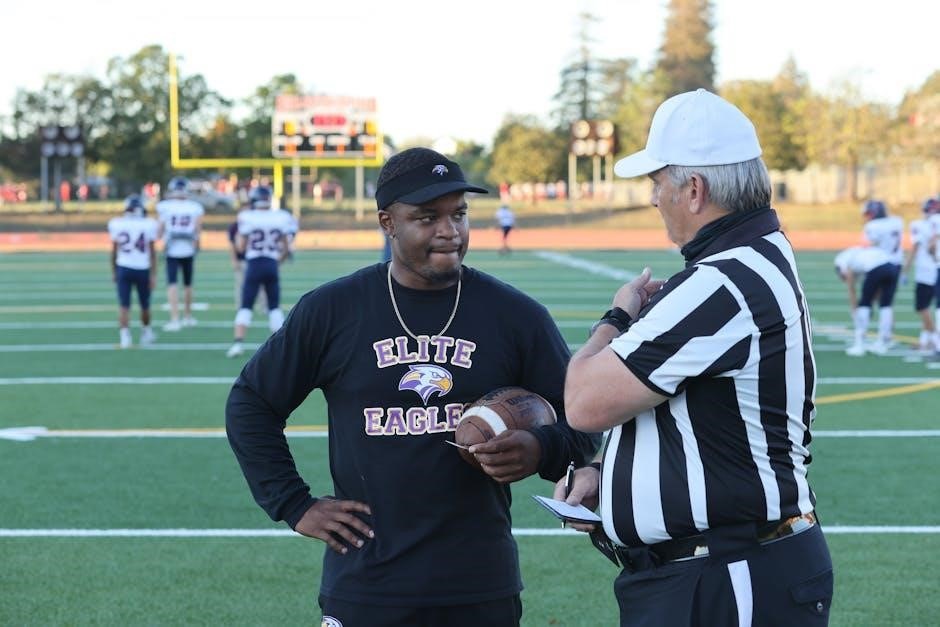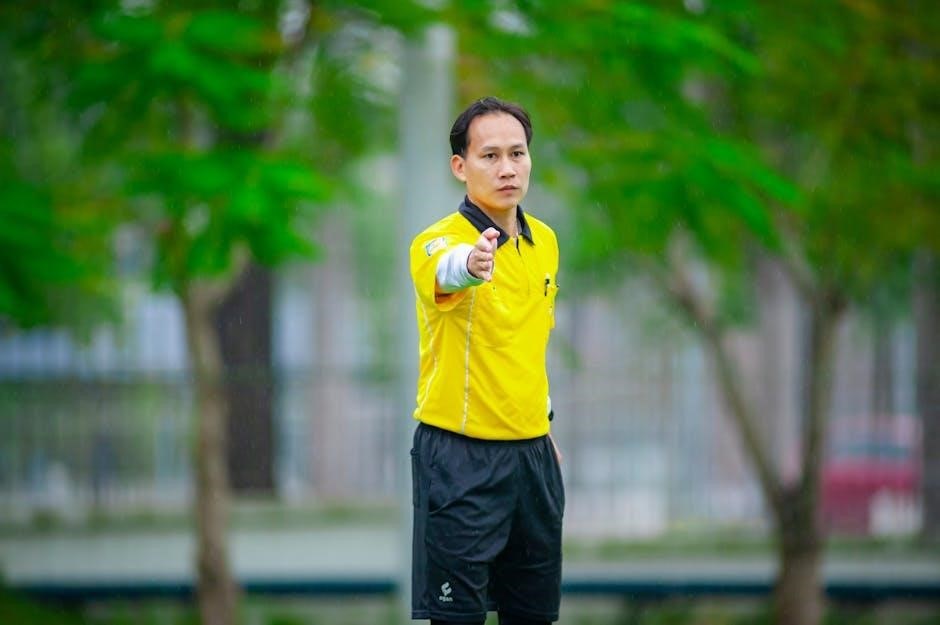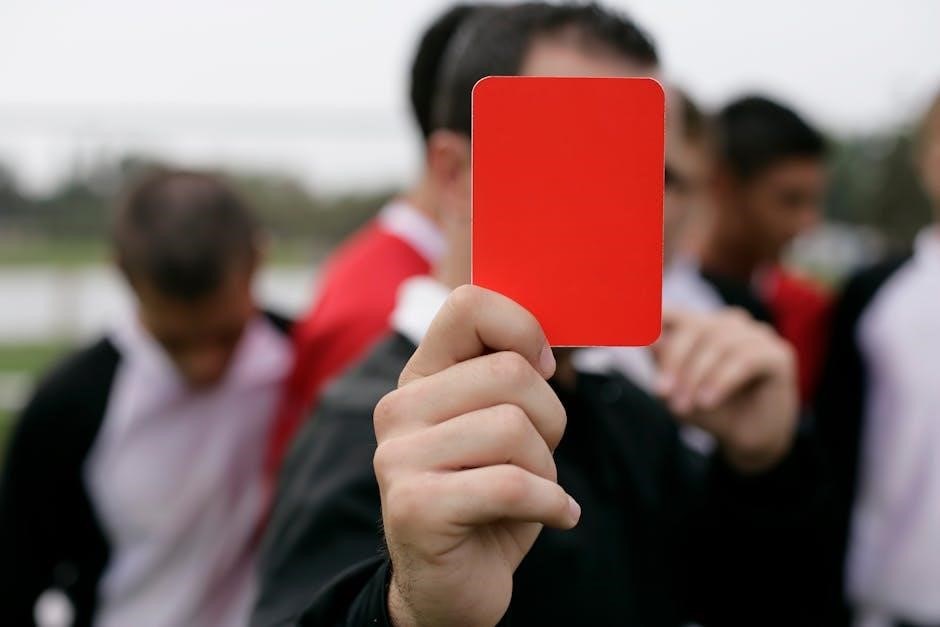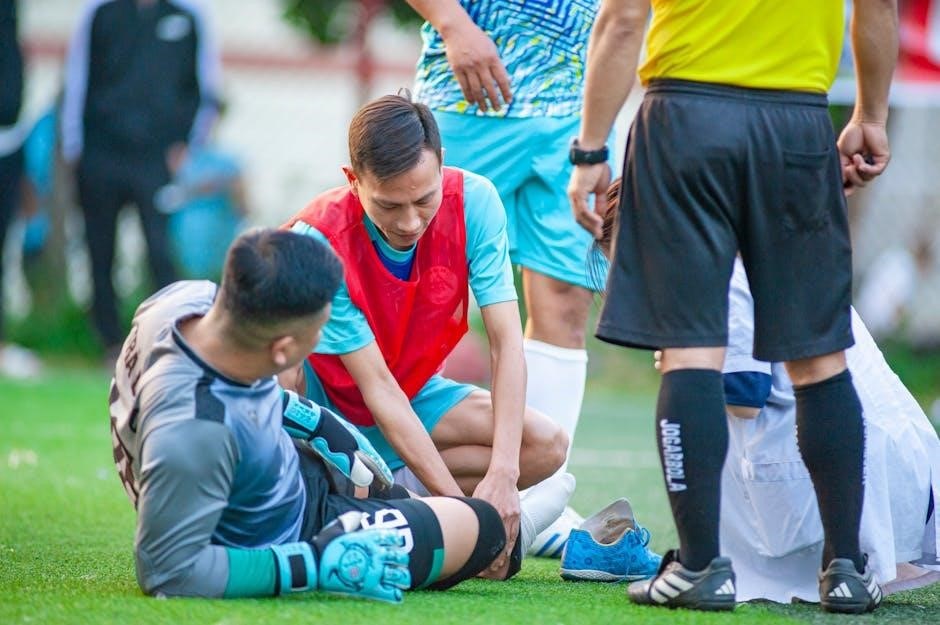FIFA plays a crucial role in standardizing football referee signals‚ ensuring consistency worldwide. These signals are essential for maintaining game flow and fair play. Recent FIFA World Cups‚ such as Qatar 2022 and the upcoming 48-team 2026 tournament‚ highlight the importance of clear communication in football.
1.1 Importance of Referee Signals in Football
Referee signals are vital for maintaining order and clarity in football matches. They ensure fair play‚ communicate decisions clearly‚ and keep the game flowing smoothly. With the introduction of VAR and other technologies‚ signals remain a cornerstone of referee communication. FIFA’s standardized signals‚ as outlined in official guides‚ help referees enforce rules consistently worldwide. This consistency is especially crucial in high-stakes tournaments like the FIFA World Cup‚ where clear communication is essential for maintaining integrity. By providing a universal language‚ referee signals reduce confusion and ensure all players and fans understand decisions. Their importance extends beyond the pitch‚ as they uphold the sport’s integrity and foster a fair competitive environment.
1.2 Brief History of Referee Signals
Referee signals in football have evolved significantly since the sport’s inception. Initially‚ referees relied on whistles and basic hand gestures to communicate decisions. As the game grew‚ the need for standardized signals became apparent to ensure consistency and clarity. FIFA played a pivotal role in formalizing these signals‚ creating a universal language for referees worldwide. Over time‚ signals have been refined to address new rules and technologies‚ such as VAR. Today‚ these signals are a cornerstone of football‚ enabling referees to manage games effectively. Their development reflects the sport’s global expansion and the increasing complexity of match officiating. Standardized signals ensure fairness and understanding‚ making them indispensable to the game’s integrity and flow.

1.3 Evolution of Referee Signal Guidelines
The guidelines for football referee signals have undergone significant transformations to align with the sport’s growth and technological advancements. FIFA has been instrumental in updating these guidelines to ensure clarity and consistency. The introduction of VAR (Video Assistant Referee) technology has necessitated new signals‚ blending traditional gestures with modern communication methods. Additionally‚ the expansion of the World Cup to 48 teams in 2026 has highlighted the need for refined signaling to accommodate larger tournaments. These updates ensure referees can effectively manage games‚ maintaining fairness and flow. The evolution of guidelines reflects FIFA’s commitment to adapting to the changing landscape of football‚ ensuring referees remain central to the sport’s integrity and success.
Types of Football Referee Signals
Football referee signals include starting‚ stopping‚ and restarting play‚ indicating fouls‚ and celebrating goals. These gestures ensure clear communication‚ maintaining game flow and player understanding worldwide.
2;1 Signals for Starting and Stopping the Game
Referees use specific signals to start and stop play‚ ensuring clarity and order. A whistle blast begins the match‚ while a raised arm signals a stoppage. These gestures‚ standardized by FIFA‚ are crucial for maintaining game flow and player understanding. Clear communication is vital‚ especially in high-stakes tournaments like the FIFA World Cup. The 2022 Qatar World Cup highlighted the importance of precise signaling to manage gameplay effectively. As football evolves‚ referees continue to rely on these foundational signals to maintain fairness and control‚ ensuring the beautiful game remains a spectacle for all.
2.2 Signals for Restarting Play
Referees employ distinct signals to restart play‚ ensuring seamless game continuation. A whistle blow often signals the restart‚ accompanied by clear arm gestures. For throw-ins‚ the referee points to the sideline‚ while corner kicks are indicated by a raised flag. Free kicks are signaled with an outstretched arm‚ and penalties with a pointed gesture to the spot. These standardized signals‚ outlined in FIFA guidelines‚ promote consistency and clarity. The 2022 FIFA World Cup in Qatar showcased the effectiveness of these signals in maintaining game flow. As football evolves‚ referees rely on these visual cues to restart play efficiently‚ ensuring fair and uninterrupted gameplay for all participants and spectators alike.
2.3 Signals for Fouls and Misconduct
Referees use specific signals to indicate fouls and misconduct‚ ensuring players and spectators understand the decisions. For fouls‚ referees often raise their arm to signal a stoppage and point to the spot where the foul occurred. Yellow and red cards are prominently displayed for cautioning or sending off players. In cases of serious misconduct‚ such as violent conduct‚ referees may use a red card immediately. These signals‚ standardized by FIFA‚ are crucial for maintaining fair play and discipline. The 2022 FIFA World Cup in Qatar highlighted the importance of clear communication through these gestures. By consistently applying these signals‚ referees uphold the integrity of the game‚ ensuring adherence to rules and promoting sportsmanship among players and teams worldwide.
2.4 Signals for Goal Celebrations and Scorers
Referees play a key role in acknowledging goals and managing celebrations. When a goal is scored‚ the referee signals by pointing to the center circle and blowing the whistle. This clear gesture confirms the goal and stops play. Additionally‚ referees may use hand signals to indicate the scorer or any foul during the celebration. FIFA guidelines ensure consistency in these signals‚ maintaining clarity for players and fans. The 2022 FIFA World Cup in Qatar showcased the importance of precise communication during goal celebrations. By standardizing these signals‚ referees ensure smooth transitions and maintain the flow of the game‚ while also respecting the excitement of scoring. These practices are essential for fair play and sportsmanship in football.
The Role of Referees in Football
Referees are central to football‚ ensuring fair play and enforcing rules. They manage game flow‚ make decisions‚ and communicate clearly with players and assistants. Their role is vital for maintaining order and sportsmanship‚ as highlighted in FIFA’s organizational statutes and recent World Cup events‚ where referees’ decisions significantly impact game outcomes and fan experiences. Their authority is crucial for the integrity of the sport‚ making them indispensable figures in every match.
3.1 Responsibilities of the Main Referee
The main referee holds ultimate authority over the match‚ ensuring rules are enforced and fair play is maintained. They manage game flow‚ make critical decisions‚ and communicate clearly with players and assistants. Key responsibilities include signaling fouls‚ managing restarts‚ and handling misconduct. The referee also oversees pre-match checks‚ monitors player behavior‚ and ensures safety. Their decisions‚ such as penalty calls or red cards‚ significantly impact the game’s outcome. FIFA’s standards emphasize consistency and accuracy‚ as seen in recent World Cup events. The referee’s role is pivotal in upholding the sport’s integrity and providing a fair environment for competition.

3.2 Role of Assistant Referees
Assistant referees play a vital role in supporting the main referee‚ ensuring accurate decisions and maintaining game flow; Their primary responsibilities include monitoring offside positions‚ signaling fouls‚ and managing throw-ins or corner kicks. They also assist in detecting misconduct and advising the main referee on key decisions. Assistant referees are positioned on the sidelines‚ providing a broader field view‚ and their signals help clarify rulings. Effective communication between the main referee and assistants is crucial for consistency. FIFA emphasizes the importance of well-trained assistants to uphold fair play and maintain the integrity of the game. Their role is essential in high-stakes tournaments like the FIFA World Cup‚ where precise decisions are critical.
3.3 Communication Between Referees and Players
Effective communication between referees and players is essential for maintaining order and clarity during a football match. Referees use a combination of verbal commands‚ hand signals‚ and body language to convey decisions. Players are expected to respect these signals‚ ensuring smooth gameplay. FIFA emphasizes the importance of clear communication to avoid misunderstandings. Referees are trained to be assertive yet approachable‚ fostering a respectful environment. This interaction is crucial for enforcing rules and maintaining fair play. By adhering to standardized signals‚ referees and players can work together to uphold the integrity of the game. Clear communication also helps in de-escalating potential conflicts‚ ensuring the match progresses without unnecessary disruptions.

Training and Certification for Football Referees
FIFA offers comprehensive training programs for referees‚ including basic and advanced certifications. These programs focus on mastering signals‚ rules‚ and physical fitness to ensure high standards in officiating.
4.1 Basic Training Requirements
Basic training for football referees involves understanding FIFA’s official signal guidelines‚ which are detailed in the football referee signals PDF. This document outlines essential hand gestures and whistle commands. Referees must also complete courses on rules‚ fitness‚ and decision-making. The training emphasizes consistency in signaling to ensure clear communication during matches. Aspiring referees must pass both theoretical and practical exams to gain certification. FIFA’s standardized approach ensures referees worldwide adhere to the same principles‚ maintaining uniformity in officiating. This foundational training is crucial for referees to manage games effectively and uphold the integrity of football.
4.2 Advanced Certification Programs
Advanced certification programs for football referees focus on refining skills and adapting to high-level competitions. These programs often include specialized training in VAR (Video Assistant Referee) technology‚ advanced fitness regimes‚ and psychological assessments. Referees learn to handle complex match scenarios and high-pressure situations. The football referee signals PDF serves as a key resource‚ detailing nuanced gestures and communication strategies. FIFA also offers elite-level workshops‚ preparing referees for international tournaments like the 2026 FIFA World Cup‚ which will feature 48 teams. These programs ensure referees are equipped to manage modern football’s demands‚ maintaining consistency and fairness globally. Advanced certification is essential for officiating at the highest levels‚ where precise signaling and decision-making are critical.
4.3 FIFA Referee Certification Process
The FIFA referee certification process is rigorous‚ ensuring officials meet global standards. It begins with fitness tests and theoretical exams‚ followed by on-field assessments. Advanced referees undergo VAR (Video Assistant Referee) training‚ crucial for modern football. The football referee signals PDF is a key resource‚ detailing standardized gestures for consistency. FIFA also emphasizes psychological evaluations to handle high-pressure scenarios. Certification is renewed annually‚ requiring referees to stay updated on rule changes. This process prepares officials for prestigious tournaments like the 2026 FIFA World Cup‚ where 48 teams will compete. The certification ensures referees are equipped to manage elite-level matches‚ maintaining fairness and clarity through precise signaling and decision-making.

Technology in Football Referee Signals
Technology enhances football referee signals through VAR‚ improving accuracy. Electronic systems aid communication‚ while innovations like AI promise future advancements‚ as detailed in the football referee signals PDF.
5.1 Use of VAR (Video Assistant Referee)
VAR (Video Assistant Referee) has revolutionized football by enhancing refereeing accuracy. Introduced in recent FIFA World Cups‚ VAR reviews key decisions like goals‚ penalties‚ direct red cards‚ and mistaken identities. This technology ensures fairness and reduces controversies. FIFA’s implementation of VAR aligns with its commitment to modernizing the sport. While debates about its impact on game flow persist‚ VAR has become a crucial tool for referees‚ providing clarity in critical moments. Its integration with electronic communication systems further streamlines decision-making‚ as outlined in the football referee signals PDF. VAR’s role is expected to expand‚ aiding referees in maintaining consistency and fairness in football.
5.2 Electronic Communication Systems
Electronic communication systems have become integral to modern football refereeing‚ enhancing decision-making accuracy. These systems‚ often integrated with VAR‚ enable referees to communicate seamlessly. Devices like smartwatches and earpieces allow referees to receive real-time feedback and coordinate decisions. FIFA has embraced this technology to maintain consistency and fairness. By streamlining communication‚ these tools reduce misunderstandings and improve overall game management. While they enhance the referee’s role‚ they do not replace human judgment. Electronic systems are detailed in football referee signals PDF guides‚ ensuring referees are well-trained in their use. This technology fosters a more efficient and transparent refereeing process‚ aligning with FIFA’s commitment to innovation in football.
5.3 Future Innovations in Referee Technology
Future innovations in referee technology aim to enhance accuracy and efficiency in football. AI-powered tools may automate decisions like offside calls‚ reducing human error. Wearable devices could provide real-time data to referees‚ aiding split-second decisions. Advanced analytics might predict foul tendencies‚ helping referees anticipate incidents. Additionally‚ blockchain could secure match data‚ ensuring transparency. FIFA is exploring these technologies to maintain fairness and modernize the sport. These advancements‚ detailed in football referee signals PDFs‚ will shape the future of refereeing‚ ensuring consistency and improving fan trust. By integrating cutting-edge solutions‚ FIFA aims to elevate the game while preserving its integrity.
Challenges Faced by Football Referees
Referees face intense pressure‚ high-stakes decisions‚ and constant scrutiny. Managing player behavior‚ maintaining consistency‚ and adapting to new technologies like VAR add complexity to their roles globally.
6.1 Pressure from Players and Fans
Football referees face immense pressure from players and fans‚ particularly in high-stakes matches. Players often protest decisions‚ while fans create a hostile atmosphere‚ impacting referees’ mental and physical well-being. The introduction of VAR has intensified scrutiny‚ as every decision is analyzed publicly. Referees must remain composed under constant criticism‚ ensuring fair play despite external pressures. This stress can affect performance‚ highlighting the need for strong mental resilience and training. The pressure is further amplified in global events like the FIFA World Cup‚ where decisions can shape tournament outcomes and face worldwide scrutiny. Managing this pressure is crucial for maintaining the integrity of the game.
6.2 Physical and Mental Demands

Football referees face significant physical and mental demands to perform effectively. Physically‚ they must maintain high fitness levels to keep up with play‚ covering distances of up to 10 kilometers per match. Mentally‚ referees need sharp focus and quick decision-making skills to interpret complex situations accurately. The stress of making split-second decisions‚ often under intense scrutiny‚ can take a toll on mental health. Additionally‚ referees must handle the physical strain of constant movement and the mental pressure of managing high-stakes games. These demands highlight the importance of rigorous training and mental resilience in refereeing. The 2022 FIFA World Cup in Qatar and the upcoming 2026 tournament underscore the need for referees to be in peak condition to manage modern football’s fast-paced nature.
6.3 Controversies and Criticism

Football referees often face criticism for controversial decisions‚ which can spark debates among fans and players. The introduction of VAR (Video Assistant Referee) has aimed to reduce errors but has also led to disputes over its implementation. Fans and players sometimes feel referees favor certain teams‚ creating tension. Additionally‚ the physical and mental demands of refereeing can lead to mistakes‚ further fueling criticism. FIFA has introduced initiatives like the peace prize to promote unity‚ but controversies persist. The 2026 World Cup‚ featuring 48 teams‚ may amplify these challenges. Despite efforts to improve accuracy‚ referees remain under scrutiny‚ highlighting the need for consistent training and clear communication to address these issues effectively.

Resources for Learning Football Referee Signals
FIFA offers official guides and PDF downloads for learning referee signals‚ ensuring consistency worldwide. Online tutorials and videos provide practical insights‚ while official FIFA websites and apps serve as comprehensive resources for referees to master the signals effectively.
7.1 Official FIFA Referee Signal Guides

FIFA provides comprehensive official guides for referee signals‚ available in PDF formats‚ ensuring global consistency. These guides detail hand signals‚ flag usage‚ and whistle blows‚ essential for clear communication. They cover game starts‚ stops‚ fouls‚ and restarts‚ aligning with FIFA’s organizational statutes. Recent updates reflect the 2026 World Cup’s 48-team format and VAR integration. FIFA’s commitment to educational resources‚ like the peace prize announcement‚ underscores their focus on fair play. These guides are vital for referees to master signals‚ ensuring uniformity worldwide. They are regularly updated to reflect rule changes‚ making them indispensable for both new and experienced referees. FIFA’s dedication to clear communication enhances the beautiful game’s integrity and flow.
7.2 Online Tutorials and Videos
Online tutorials and videos are invaluable resources for learning football referee signals. FIFA’s official website and platforms like YouTube offer extensive libraries of instructional content. These resources provide visual demonstrations of hand signals‚ flag gestures‚ and whistle blows‚ making complex rules easier to understand. Many tutorials are designed for referees at all levels‚ from beginners to experienced officials. They often include real-game scenarios‚ highlighting how signals are applied in practice. Additionally‚ live match replays and highlights from events like the FIFA World Cup and U-17 Women’s World Cup offer practical insights. These online tools complement PDF guides‚ allowing referees to see signals in action and improve their decision-making skills. They are accessible anytime‚ making them a flexible learning option for referees worldwide.
7.4 Football Referee Signal PDF Downloads
FIFA and other football governing bodies provide official PDF guides for referee signals‚ offering detailed explanations and visual representations. These downloadable resources are essential for referees to understand and master the latest signal protocols. The PDFs often include illustrations of hand gestures‚ flag signals‚ and whistle blows‚ along with explanations of when and how to use them. They are regularly updated to reflect rule changes and technological advancements‚ such as VAR integration. Referees worldwide rely on these PDFs to ensure consistency in their decision-making. FIFA’s official website and affiliated platforms make these resources easily accessible‚ supporting referees in their training and professional development; These guides are indispensable for maintaining uniformity in refereeing standards across all levels of football.
FIFA provides official football referee signal PDFs‚ essential for training and consistency. These resources ensure referees worldwide understand and apply signals accurately‚ maintaining fair play and uniformity in football.
8.1 Summary of Key Points
FIFA plays a pivotal role in standardizing football referee signals‚ ensuring consistency across global tournaments like the 2022 World Cup in Qatar and the upcoming 48-team 2026 World Cup. Official FIFA resources‚ including football referee signal PDFs‚ provide detailed guidelines for referees to maintain fair play and uniformity. These documents outline essential signals for game management‚ fouls‚ and celebrations‚ aiding referees in clear communication. The evolution of referee signals‚ supported by technology like VAR‚ enhances accuracy and transparency. Training programs and certifications ensure referees are well-prepared to handle high-pressure situations. Understanding these signals is crucial for players‚ fans‚ and officials alike‚ fostering a cohesive and fair football environment worldwide.
8.2 Importance of Understanding Referee Signals

Understanding referee signals is vital for ensuring fair play and smooth game flow in football. FIFA’s standardized signals‚ detailed in football referee signal PDFs‚ help players‚ coaches‚ and fans interpret decisions accurately. This clarity reduces confusion and disputes‚ fostering a more enjoyable experience for everyone involved. Referee signals also promote consistency across different matches and leagues‚ maintaining the integrity of the sport. By adhering to these guidelines‚ referees can effectively communicate their decisions‚ ensuring that the game is played according to the rules. This understanding is especially crucial in high-stakes tournaments like the FIFA World Cup‚ where clear communication is essential for maintaining order and fairness.
8.3 Final Thoughts on the Role of Referees
Referees are the backbone of football‚ ensuring fair play and adherence to rules. Their role extends beyond officiating‚ as they maintain game flow and uphold the sport’s integrity. With the introduction of technologies like VAR‚ referees must adapt to new tools while remaining impartial. FIFA’s initiatives‚ such as the peace prize and global tournaments‚ highlight the importance of referees in fostering unity and sportsmanship. Their decisions‚ guided by standardized signals‚ impact the outcome of matches and the overall enjoyment of the game; As football evolves‚ referees must continue to balance tradition with innovation‚ ensuring the sport remains a global unifier. Their dedication and expertise are indispensable to the beautiful game’s success and legacy.

Be First to Comment